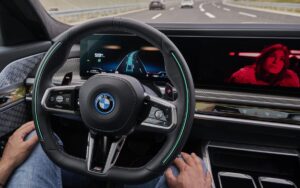The B.C. government’s ban on Level 3 and over autonomy in vehicles is meant to protect vulnerable road users in the province

British Columbia is banning highly automated self-driving vehicles on public roads. Photo: BMW
The B.C. government’s ban on Level 3 and over autonomy in vehicles is meant to protect vulnerable road users in the province
This month, British Columbia updated its Motor Vehicle Act to ban highly automated self-driving vehicles on public roads.
As of April 5, the new B.C. law states cars with Level 3, Level 4, or Level 5 autonomy can’t drive on public roads or use high automation self-driving systems. The exception is vehicles that are part of a government-approved pilot project, states the B.C. government.
Penalties for driving such a vehicle — even without the self-driving features in use — include a $368 to $2,000 fine and 6 months in jail.
Why the ban?
The B.C. government says the ban will enhance the safety of vulnerable road users, including cyclists and pedestrians.
“These new regulations will keep people safer on our roads and encourage even more use of active transportation,” said Rob Fleming, minister of transportation and infrastructure, in a press release. “It’s another step in modernizing our rules to keep up with new technologies that are changing how people are getting around.”
Commenting on the ban, Vince Amodeo, director and Technology Practice lead, and Nicole Brassard, vice president, British Columbia and the co-chair of the Technology Practice at Global Public Affairs, tells Electric Autonomy in an email that the ban is “in keeping with British Columbia’s traditional outlook, the government is taking a cautious approach to autonomous vehicles when compared to other jurisdictions. However, it is important to note that there are no Level 3 autonomous vehicles for sale in Canada at present so the urgency from a regulatory perspective is somewhat lessened.”
While the provincial government acknowledges that highly automated self-driving vehicles will one day be a part of its residents’ lives, it emphasizes that these vehicles “remain a new and emerging transportation technology.”
The B.C. government states: “Further testing and policy development are necessary before Level 3 or higher automated vehicles are considered safe and can begin to be allowed for public use on B.C. roads.”
Amodeo and Brassard add: “It is always better to be balanced and accurate than first. This wait-and-see approach has served [B.C.] well in the past.”
Automated vehicle levels and availability
The Society of Automotive Engineers (SAE) categorizes vehicle automation into a 0 to 5-level system.
Vehicles at Level 0 have no automation. Those at Levels 1 and 2 offer automated driver-assistance features like lane change assist or automatic braking. Levels 3 to 5 represent high to fully automated self-driving capabilities.
While there are no Level 3-5 self-driving vehicles in Canada, in the US, Mercedes-Benz offers its Drive Pilot system with Level 3 autonomy. The Drive Pilot system has approval for use only in California and parts of Nevada. It operates in heavy traffic at speeds up to 65 km/h. It is also available in Europe.
BMW is also ready to release its optional Level 3 Personal Pilot L3 pack in its new BMW 7 Series. The system is available only in Germany and will function on separated highways at a maximum speed of 60 km/h. It is not available in North America.
Just last week, Tesla introduced its Full Self-Driving (FSD) subscription in Canada for $99 per month. Tesla’s FSD and Autopilot systems are classified as Level 2 autonomy.












